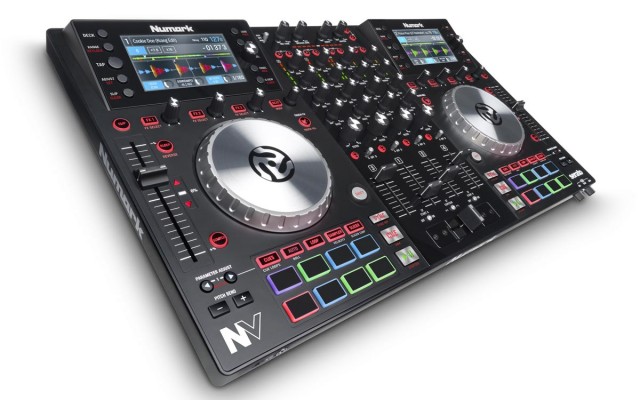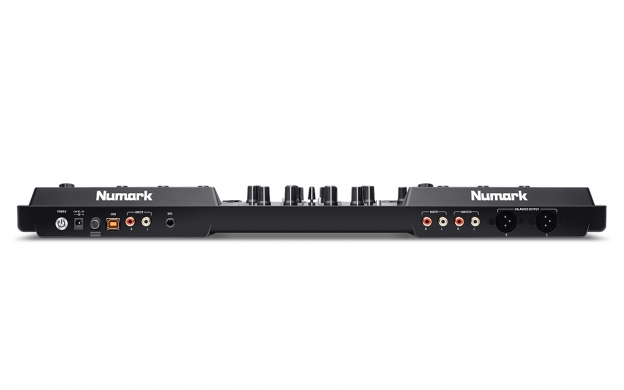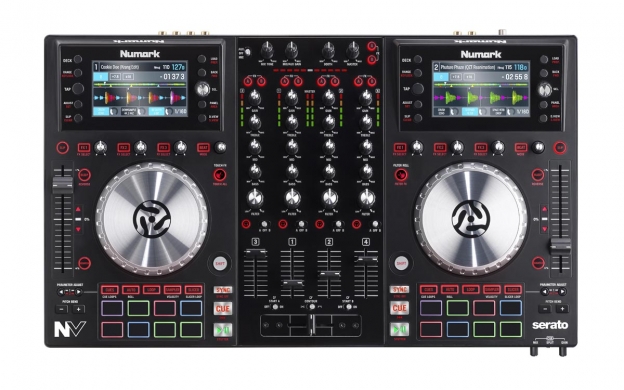In the digital age, the metaphor for DJing has been fragmented. You’ve got big wheels, but they represent missing turntables and don’t provide visual feedback. You’ve got CDJs, but then the waveform and the wheel are still separate. You’ve got vinyl records, but then you have to look at a computer screen to see where you are in the track. (A recent presentation at the NIME conference projected images on the record – see below – but projectors lack enough resolution for cue points on the vinyl.)
The iPad is the one device that seems to get it right. It displays a waveform, and by touching the waveform, you can navigate the sound. The cost, though, is all the other tangible, physical controls – iPads’ virtual faders and knobs just aren’t as satisfying to use as the real thing.
Oh, and then you also have controllers that focus instead on trigger points and percussive slicing on a grid — essentially, the MPC as found on a DJ controller.
Numark’s NV is either the first of a new generation of controllers, or the last gasp of all the remaining idioms. Or maybe it’s a little of each.
Displays for waveform views of decks. You get color waveform displays as on something like a CDJ or your computer screen. You can’t touch them as on the iPad – but at least you don’t have to look at your computer. And the displays are really nice, a “1:1” view of what you’d see on a computer display in Serato – at least of each deck. (For everything else, there are physical controls.) There are two dedicated displays, but you can switch them among four decks.
– and displays for library navigation. Just to make sure you really aren’t looking at that laptop, the displays double as a way of browsing your library.
Big wheels. As on the CDJ and many controllers, wheels stand in for the feeling of using a turntable deck.
Knobs and faders, mixer style. Dedicated EQ, filter, effect, mixing, and the like – real knobs and faders. The knobs are capacitive, so you can switch modes, including multiple filter modes that add, if you desire, effects. And these also allow you to add “effects tweaking, EQ kills, and filter sweeps” – though that stuff always makes me shudder a little in fear of hyper-active DJs.
Velocity-sensitive pads. Yes, you get 16 drum pads, which do everything you’d expect – triggering samples (with velocity if you like), jumping to cues and loops, and slicing.
Audio I/O. Thankfully with something this big, you don’t have to carry an audio interface. You get everything you need – booth/master RCA outputs plus balanced XLR outs. Nice. Sorry, I have to do this. Dear Native Instruments: You know how you say we don’t want audio jacks, as on hardware like Maschine Studio? We want them. I want them. I don’t know what focus group decided the audio jacks were unnecessary, but having lugged a Maschine Studio and an audio interface around and burnt through both of my MacBook’s two USB ports, I suspect this is the sort of focus group that would declare I don’t want ketchup or mayo on my fries (I want both, actually), and then would proceed to punch me in the face because they didn’t like my beard. I’m not the world’s highest-paid DJ or live performer, but I’ve found every gig I’ve played involved me, audio cables, and a PA, unless this focus group is exclusively working on network-distributed silent discos. Done with that rant, thank you.
Ahem.
Back to the original question: does it make sense to combine all these features like this?
Capacitive knobs are a smart idea – they respond to twisting as do normal knobs, but also if you touch them lightly and don’t move them. We’ve seen them on other hardware, but they’re a good match for DJ controllers.
You also get an impressive complement of dedicated controls, all of it tailored to four decks, not just two.
And there appear to be some really terrific details as far as the Serato integration, including supporting different templates and customization (“Flips”).
And the price is impressive: $699.99 USD list (not street), with those displays, is a new benchmark to beat.
So, no question: for certain Serato users, this will be a godsend.
I just wonder about the number of clashing metaphors both here and in DJ controllers, generally. There are pads, like on an MPC. There’s a waveform. But you can’t touch the waveform. You control it using a wheel, which is a metaphor borrowed from the vinyl turntable. That wheel can’t do everything you need, so you also control the waveform with pads – like on an MPC. But all of that is in turn combined with something that looks like a mixer.
And once you add that many things together, you get something freakin’ huge. A lot of people swear by this layout, and it definitely looks possible to hide your laptop and not look at it. (That’s a very good thing.) But if you’re a DJ who needs to work in close quarters, you’re out of luck.
I’ve seen people use controllers like this and play really good sets. If you’re looking for a single controller that has pads and wheels and lots of dedicated controls — and you also don’t want to look at your computer screen — this could be your solution. And I’m happy to see displays here rather than something like an iPad dock (now doubly dated since Apple killed the connector that made them work).
I’m also interested to try those touch-enabled knobs.
The NV may be a lot of fun to play now; we’ll know as it ships. But it seems digital DJing hasn’t yet entirely escaped a mishmash of metaphors and history. From digital control vinyl to hardware that fakes turntables and mixers, we’ve yet to see hardware that seamlessly fuses the control method with the digital possibilities inside. The question now is, will these keep evolving, like a generation of animals emerging from the sea, shedding extra limbs no longer needed? Or will there be hardware that can do what the iPad (or even something like the monome) did: make a clean slate?
There, too, I suspect the answer to the either/or question is “yes.” If I’m right, it’ll be fun to watch.
http://www.numark.com/microsites/nv


